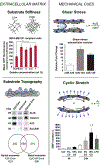Towards rationally designed biomanufacturing of therapeutic extracellular vesicles: impact of the bioproduction microenvironment
- PMID: 30218694
- PMCID: PMC6250573
- DOI: 10.1016/j.biotechadv.2018.09.001
Towards rationally designed biomanufacturing of therapeutic extracellular vesicles: impact of the bioproduction microenvironment
Abstract
Extracellular vesicles (EVs), including exosomes, microvesicles, and others, have emerged as potential therapeutics for a variety of applications. Pre-clinical reports of EV efficacy in treatment of non-healing wounds, myocardial infarction, osteoarthritis, traumatic brain injury, spinal cord injury, and many other injuries and diseases demonstrate the versatility of this nascent therapeutic modality. EVs have also been demonstrated to be effective in humans, and clinical trials are underway to further explore their potential. However, for EVs to become a new class of clinical therapeutics, issues related to translation must be addressed. For example, approaches originally developed for cell biomanufacturing, such as hollow fiber bioreactor culture, have been adapted for EV production, but limited knowledge of how the cell culture microenvironment specifically impacts EVs restricts the possibility for rational design and optimization of EV production and potency. In this review, we discuss current knowledge of this issue and delineate potential focus areas for future research towards enabling translation and widespread application of EV-based therapeutics.
Keywords: Biomanufacturing; Exosome; Extracellular vesicle; Mesenchymal stem cell; Microenvironment.
Copyright © 2018 Elsevier Inc. All rights reserved.
Figures





References
-
- Abagnale G, Steger M, Nguyen VH, Hersch N, Sechi A, Joussen S, Denecke B, Merkel R, Hoffmann B, Dreser A, Schnakenberg U, Gillner A, Wagner W, 2015. Surface topography enhances differentiation of mesenchymal stem cells towards osteogenic and adipogenic lineages. Biomaterials 61, 316–326. https://doi.org/http://doi.org/10.1016/j.biomaterials.2015.05.030 - DOI - PubMed
-
- Ader M, Tanaka EM, 2014. Modeling human development in 3D culture. Curr. Opin. Cell Biol 31, 23–28. https://doi.org/https://doi.org/10.1016/j.ceb.2014.06.013 - DOI - PubMed
-
- Aharon A, Tamari T, Brenner B, 2008. Monocyte-derived microparticles and exosomes induce procoagulant and apoptotic effects on endothelial cells. Thromb. Haemost 100, 878–885. https://doi.org/10.1160/TH07-11-0691 - DOI - PubMed
-
- Alvarez-Erviti L, Seow Y, Yin H, Betts C, Lakhal S, Wood MJA, 2011. Delivery of siRNA to the mouse brain by systemic injection of targeted exosomes. Nat Biotech 29, 341–345. - PubMed
-
- Aswad H, Jalabert A, Rome S, 2016. Depleting extracellular vesicles from fetal bovine serum alters proliferation and differentiation of skeletal muscle cells in vitro. BMC Biotechnol 16, 32 https://doi.org/10.1186/s12896-016-0262-0 - DOI - PMC - PubMed
Publication types
MeSH terms
Grants and funding
LinkOut - more resources
Full Text Sources
Other Literature Sources

